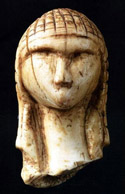Anthropology, Department of

Department of Anthropology: Faculty Publications
ORCID IDs
Heather Richards-Rissetto https://orcid.org/0000-0002-8086-0072
Kristin Landau https://orcid.org/0000-0001-6693-906X
Document Type
Article
Date of this Version
8-21-2019
Citation
Richards-Rissetto, H. and Landau, K., 2019. Digitally-Mediated Practices of Geospatial Archaeological Data: Transformation, Integration, & Interpretation. Journal of Computer Applications in Archaeology, 2(1), pp.120–135. DOI:http://doi.org/10.5334/jcaa.30
Abstract
Digitally-mediated practices of archaeological data require reflexive thinking about where archaeology stands as a discipline in regard to the ‘digital,’ and where we want to go. To move toward this goal, we advocate a historical approach that emphasizes contextual source-side criticism and data intimacy—scrutinizing maps and 3D data as we do artifacts by analyzing position, form, material and context of analog and digital sources. Applying this approach, we reflect on what we have learned from processes of digitally-mediated data. We ask: What can we learn as we convert analog data to digital data? And, how does digital data transformation impact the chain of archaeological practice? Primary, or raw data, are produced using various technologies ranging from Global Navigation Satellite System (GNSS)/Global Positioning System (GPS), LiDAR, digital photography, and ground penetrating radar, to digitization, typically using a flat-bed scanner to transform analog data such as old field notes, photographs, or drawings into digital data. However, archaeologists not only collect primary data, we also make substantial time investments to create derived data such as maps, 3D models, or statistics via post-processing and analysis. While analog data is typically static, digital data is more dynamic, creating fundamental differences in digitally-mediated archaeological practice. To address some issues embedded in this process, we describe the lessons we have learned from translating analog to digital geospatial data—discussing what is lost and what is gained in translation, and then applying what we have learned to provide concrete insights to archaeological practice.
Included in
Archaeological Anthropology Commons, Digital Humanities Commons, Geographic Information Sciences Commons, Landscape Architecture Commons, Other History Commons, Other History of Art, Architecture, and Archaeology Commons, Social and Cultural Anthropology Commons, Spatial Science Commons, Urban, Community and Regional Planning Commons


Comments
Copyright: © 2019 The Authors. This is an open-access article distributed under the terms of the Creative Commons Attribution 4.0 International License